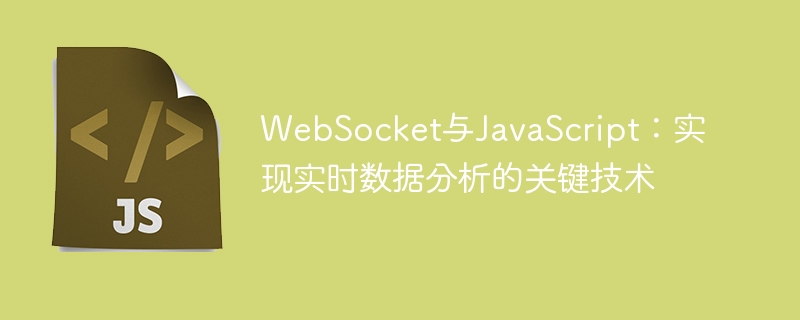Home >Web Front-end >JS Tutorial >WebSocket and JavaScript: Key technologies for real-time data analysis
WebSocket and JavaScript: Key technologies for real-time data analysis
- PHPzOriginal
- 2023-12-18 10:33:421352browse

WebSocket and JavaScript: Key technologies for real-time data analysis
Introduction:
In the current Internet era, real-time data analysis is very important for enterprises and individual users are becoming more and more important. Real-time data analysis can help companies quickly grasp market dynamics and improve operational strategies. For individual users, real-time data analysis can help us better understand our own behaviors and preferences and make smarter decisions. One of the key technologies to achieve real-time data analysis is the use of WebSocket and JavaScript.
1. Introduction to WebSocket
WebSocket is a new communication protocol in HTML5, which enables full-duplex communication between the client and the server. Compared with traditional HTTP request methods, WebSocket has the following advantages:
- Low latency: Compared with HTTP long polling, WebSocket communication has lower latency and better real-time performance;
- Two-way communication: WebSocket can achieve two-way communication between the client and the server, and the server can actively send messages to the client;
- Efficient transmission: The data packet header of WebSocket communication is smaller and the data transmission efficiency is higher .
2. JavaScript to implement WebSocket communication
Using JavaScript to implement WebSocket communication is very simple and can be completed with just a few lines of code:
var socket = new WebSocket('ws://localhost:8080'); // 创建WebSocket对象
socket.onopen = function() {
console.log('WebSocket连接已打开');
};
socket.onmessage = function(event) {
var data = event.data;
console.log('收到服务器消息:', data);
// 在此处进行数据分析和处理
};
socket.onclose = function() {
console.log('WebSocket连接已关闭');
};In the above code, we use WebSocket API to create WebSocket objects, and set up several callback functions, corresponding to the three events of WebSocket connection opening, message reception and connection closing.
3. Key technologies for real-time data analysis
- Data collection: In real-time data analysis, you first need to collect data from various data sources. Data can be collected in different ways, such as using JavaScript to track user behavior, receiving push data from the server, etc.
- Real-time transmission: After collecting the data, the data needs to be transmitted to the server in real time through WebSocket for analysis. Using the two-way communication feature of WebSocket, the server can actively push messages to the client to achieve real-time transmission.
- Data analysis: After the client receives the data from the server, we can analyze and process the data through JavaScript. For example, you can use chart libraries to visualize data, perform statistics and filter data to better understand the data.
- Result display: Finally, the analyzed and processed data results are displayed to the user. The data results can be displayed on the web page through JavaScript, or the data results can be output in the form of reports, charts, etc.
4. Code example: Real-time data analysis
The following is a code example that demonstrates how to use WebSocket and JavaScript to implement real-time data analysis, taking online game online population statistics as an example:
// 客户端代码
var socket = new WebSocket('ws://localhost:8080');
socket.onmessage = function(event) {
var data = JSON.parse(event.data);
if (data.type === 'onlineCount') {
console.log('当前在线人数:', data.count);
// 在此处进行数据分析和处理,例如将在线人数展示在网页上
}
};
// 服务器端代码
var WebSocketServer = require('ws').Server;
var wss = new WebSocketServer({ port: 8080 });
var onlineCount = 0;
wss.on('connection', function(ws) {
onlineCount++;
ws.send(JSON.stringify({ type: 'onlineCount', count: onlineCount }));
ws.on('close', function() {
onlineCount--;
wss.clients.forEach(function(client) {
if (client.readyState === WebSocket.OPEN) {
client.send(JSON.stringify({ type: 'onlineCount', count: onlineCount }));
}
});
});
});In the above code, after the client connects to the WebSocket server, the server will send a message about the number of people online to the client. After the client receives the message, it can analyze and process the data on the number of people online, for example, display it on the web page. The server will update the number of people online in real time based on client connections and disconnections, and send the updated number of people online to all clients.
Conclusion:
The combination of WebSocket and JavaScript can achieve real-time data analysis and help us better understand and utilize data. Through the two-way communication feature of WebSocket, data is transmitted to the server in real time for analysis, and JavaScript is used to process and display the data, which can meet the needs of real-time data analysis. Therefore, in the field of real-time data analysis, WebSocket and JavaScript are an important pair of key technologies.
The above is the detailed content of WebSocket and JavaScript: Key technologies for real-time data analysis. For more information, please follow other related articles on the PHP Chinese website!

